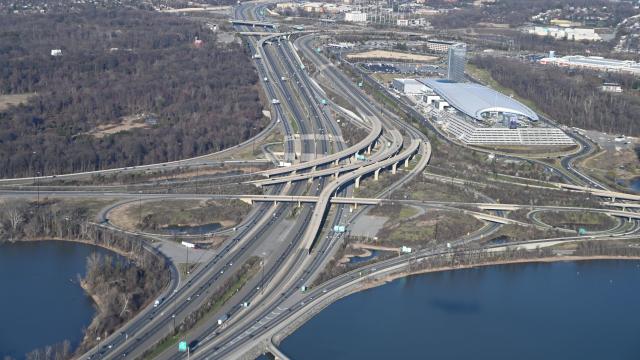Americans drove 40 per cent more miles in 2019 than they did in 1994, according to the U.S. Department of Transportation. More driving means more congested traffic. So to reduce congestion, it makes sense to build more highway lanes so that more cars can fit. Right? Actually, no. A new report from the policy organisation Transportation for America shows that doesn’t work at all.
Between 1993 and 2017, the researchers found that the largest urban areas in the U.S. added 30,511 new lane-miles (49,000 kilometres) of roads—a 42 per cent increase. That’s a faster rate of growth than population growth, which rose by 32 per cent in those cities over the same time period.
But in that 24 year period, traffic congestion didn’t drop at all. In fact, it rose by 144 per cent even as states spent more than $US500 ($758) billion on highway capital investments in urbanised areas, and a sizable portion of which went toward highway expansion. That means governments spent billions, and the end result was Americans wasting more time frustrated on the highway, sitting in cars that spew out climate-warming and neighbourhood-polluting emissions.
That’s because when you build more highways, people start driving more and filling up the lanes in a matter of years. From 1993 to 2017, the average person drove 20 per cent more miles. Right after a highway is widened, traffic does speed up, and drivers take advantage of that by “switching from other routes, driving further distances or travelling during the busiest time of the day,” the report, which looked at federal and state data on traffic and freeway growth, says. “People who had previously avoided congestion—whether by riding transit, carpooling, travelling during less congested times of day, or foregoing the trip altogether—start driving on that route more because it has become more convenient.”
People even start moving further away from central metro areas because the increasing number of roads makes it a more appealing, cheaper option. But as cities sprawl out, that creates the need to drive more, which in turn creates more traffic. Within a few years of a highway expansion (which costs millions of dollars of public money), traffic increases enough that the roads become congested again. Drivers become frustrated, and elected officials respond by—surprise!—pushing to expand highways to reduce congestion. Then, the whole cycle starts over again.
The analysis shows this pattern occurs all over the country, from San Diego and Nashville to Pensacola and Buffalo. Even cities that saw relatively low population growth didn’t decrease traffic congestion by expanding freeway networks. Jackson, Mississippi’s population grew by just nine per cent between 1993 and 2017 while the region expanded its freeways by over 60 per cent. The end result? The region still faced a 317 per cent increase in traffic.
For drivers, this means dealing with a colossal waste of time. A separate study released by the transportation analytics firm INRIX on Monday shows that drivers on average spent an average of 99 hours in traffic last year, up two hours compared to 2017.
All this traffic also produces pollution. The average car emits about 4.6 metric tons of carbon dioxide per year, and the transportation sector is responsible for 29 per cent of U.S. greenhouse gas emissions.
All those emissions warm the climate while other types of emissions pollute the air, creating all sorts of health problems. That’s especially true for those in poorer neighbourhoods of colour, who are far more likely to breathe polluted air from cars and other sources.
As the researchers show, it doesn’t have to be this way. The U.S. can and should fundamentally change how it approaches transportation.
“Focusing on congestion mitigation misses the bigger picture,” the report says. “We should be prioritising investments based on how well they connect people to jobs and services, not how much more quickly cars will be able to travel on a certain segment of highway.”
To truly reduce traffic, the report says, officials must improve access to work, education, healthcare, groceries, recreation, and other daily needs. That means measuring accessibility between destinations instead of highway delays, and prioritising highway maintenance instead of expansion. It also means making cities safer for pedestrians, so that residents don’t have to drive to take short trips.
Importantly, Americans cities also desperately need to improve public transit, which would improve access to destinations and lower car emissions. As Aaron Gordon at Vice points out, the U.S. has been truly awful at building public transportation. But this year, we’ve got a chance to change that. The current authorization for federal transportation spending is set to be renegotiated in 2020. Once passed, it will set federal funding levels for transportation for another five years.
“With discussions underway about the next federal transportation legislation—a process that only happens every five years—now is the critical time to make changes before we pour billions more into a solution that doesn’t work,” the report says. “We cannot keep relying on the same expensive and ineffective approach.”
